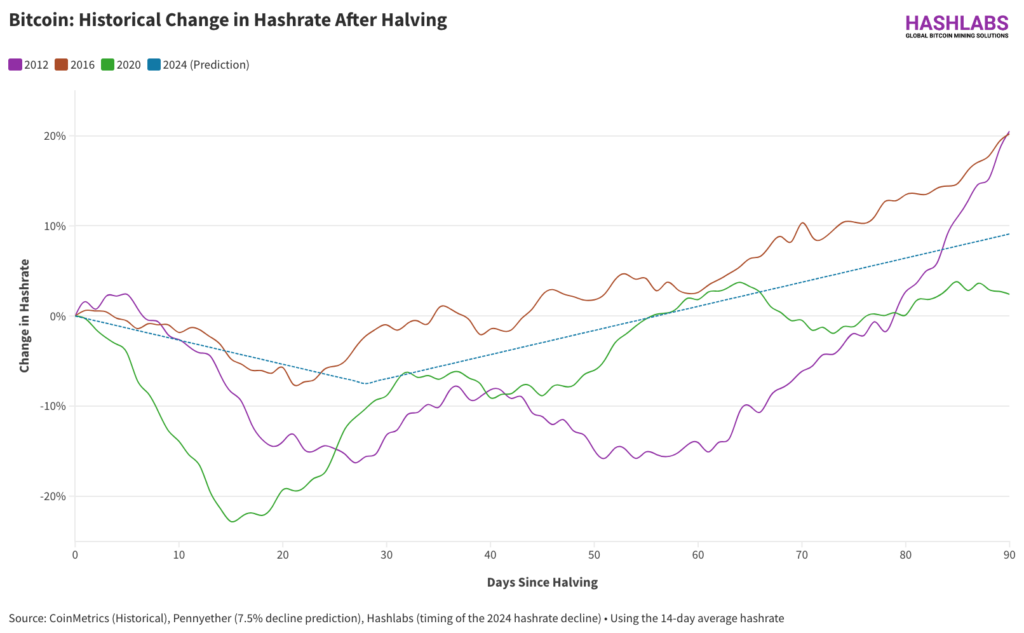
In a few days, the fourth Bitcoin halving in history will occur, and the trading community is eagerly anticipating potential exponential increases in Bitcoin’s price. However, an important question arises: what will happen to Bitcoin mining? As the reward for mining Bitcoin will be halved, miners will face unchanged costs but reduced rewards. This raises concerns about whether miners will continue their operations under such conditions.
Historical Impact on Hashrate
Each previous halving has resulted in a significant decrease in the network’s hashrate. Initially, there was a 25% drop in 2012, followed by a smaller 11% drop in 2016, and another 25% reduction in 2020. This year’s halving, however, is anticipated to show a different trend. The Hashrate Index suggests a modest decrease of only 3-7% in hashrate. These predictions are influenced by the current high prices of Bitcoin and the lucrative profitability of mining operations, which may cushion the blow of reduced rewards.

Technological Adaptation and Efficiency
Nearly 70% of the network’s mining devices have been operational since January 2022, a period when Bitcoin’s price was significantly lower and mining conditions were more challenging. Despite the upcoming reward reduction, the industry expects only a temporary decline in hashrate, which historically has returned to pre-halving levels within an average of 57 days in previous cycles.
Other Articles
The Necessity for Equipment Upgrades
Economic pressures will inevitably push some miners into losses, particularly those with high operational costs and older, less efficient equipment. Currently, many miners are using outdated models like the Antminer S19J Pro, which requires electricity costs to be around $0.05 per kWh to maintain profitability after the halving. In contrast, the majority of U.S. miners face higher electricity costs of $0.08 per kWh, suggesting a forthcoming wave of substantial upgrades and replacements with more efficient machines, such as the new Antminer S21, capable of mining 1 BTC for around $22,000 in costs even post-halving.
Diversification of Revenue Streams
Miners are not solely reliant on Bitcoin mining for revenue. The drop in Bitcoin’s price last year compelled many to explore alternative revenue streams. This approach is less urgent with the current rebound in prices but could become critical again post-halving. For example, companies like Hashlabs in Finland have successfully diversified by selling waste heat to district heating systems, leveraging the stabilization of the electrical grid, and selling electricity back to the market during peak pricing times. These strategies have helped them not only stabilize but also diversify their income, reducing the risk of revenue disruptions.
Towards Greater Decentralization of Mining
The future of mining appears to be steering towards not only enhancing efficiency but also reducing operational costs, particularly electricity. Some miners might choose to build their own power plants or relocate to regions with cheaper electricity, such as Africa, Latin America, or Asia. Notably, significant proportions of Bitcoin mining now occur in the USA (40%), China (15%), and Russia (12%). New entrants like Bitfarms, Bitdeer, and Marathon are expanding into Argentina, Bhutan, the UAE, and Paraguay, signaling a shift towards more decentralized mining operations.
Final Impact on Bitcoin’s Price: A Detailed Perspective
The final impact of the halving on Bitcoin’s price remains a complex issue. Traditionally viewed as a bullish event, the outcome this year is clouded with uncertainty. The reduction in mining rewards from 6.25 BTC to 3.125 BTC—a cut of approximately three coins per block—significantly alters daily Bitcoin output, dropping from about 900 BTC to 450 BTC. This substantial reduction could have been a shock to the system, yet several factors might mitigate such a reaction.
Firstly, the growing institutional interest, exemplified by the recent approval of spot Bitcoin ETFs in the United States, has reinvigorated the market. This has increased the liquidity and buying pressure, which may absorb some of the shock from the reduced mining output. Secondly, the current stock of Bitcoin on exchanges and the volume of daily transactions, including those from spot ETFs, suggest that while the supply is tightening, demand remains robust. This dynamic could prevent a sharp, immediate impact on Bitcoin’s price, instead potentially leading to a more gradual adjustment.
In summary, while the halving is likely to pose challenges for miners in terms of profitability and operational efficiency, it also opens opportunities for technological advancement and diversification of income sources. As for Bitcoin’s price, the event may not lead to the dramatic spikes seen in previous years but could still support a steady appreciation over time, contingent on broader market dynamics and investor sentiment.







